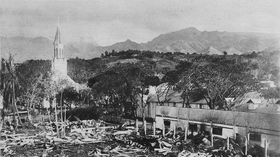Frontier War
| Frontier War | |||||||||
|---|---|---|---|---|---|---|---|---|---|
| |||||||||
| Belligerents | |||||||||
|
Expand
Supported by: |
Expand
Supported by: | ||||||||
| Commanders and leaders | |||||||||
|
|
| ||||||||
| Units involved | |||||||||
|
Vierz Empire: 225,000 regulars 450,000 colonial troops 12 pre-dreadnought battleships 7 dreadnought battleships 2 battlecruisers Loyalists: 50,000 militia |
Vonzumier: 725,000 infantry 8 pre-dreadnought battleships 4 dreadnought battleships Artalian defectors: ~70,000 irregulars | ||||||||
The Frontier War (Vierz: Grenze Krieg) was a four-year armed conflict between the Vierz Empire and Vonzumier. The war began on 14 May 1915 when Vonzumier declared war on Vierzland, and it ended on 7 March 1919 when a Tieradan-brokered armistice was signed. The war broke out after Vierzland provoked Vonzumier after years of disputes over the Darbut Lakes. Vonzumier aimed to gain sovereignty over the region and gain the respect of the Patyrian power, while Vierzland wanted to humiliate Vonzumier and cement its colonial rule over the northern end of South Artalia.
After Vonzumier's declaration of war, Vierz forces made the first moves on the battlefield. They took advantage of an under-equipped and poorly-trained Vonzumerian military, but by 1917 were forced into a stalemate situation after a number of costly battles. Vonzumier received the support of Tierada, Apelia, Luepola, and others, who aimed to undermine Vierz geopolitical power.
Economic difficulties, military defeats, falling morale, and war-weariness at home led Vierz emperor Victor II to seek an armistice with Vonzumier, brokered by Tierada. The Treaty of Luchtenburg resulted in the transfer of a broad strip of Vierz land in South Artalia to Vonzumier, including the Amplian seaport of Opnacht.
The war was significant in human history for its brutality; chemical weapons, human wave attacks, and trench warfare were commonplace. The conflict saw the first use of the tank in the history of war, as well as widespread use of machine guns. It is estimated that anywhere between 2 million and 3 million people, mostly civilians, died as a result of the conflict, most of whom perished from disease due to the pervasive destruction laid to civilian infrastructure.
The result of the conflict had an immense social, cultural, and political impact in both Vierzland and Vonzumier. Vonzumier's sovereignty as an independent state was cemented by its total victory; national honour and patriotism were at an all-time high. Vierzland, however, was humiliated by its former colony, and national opinion was intensely cynical and bitter. The consequences of this would lead to a number of geopolitical developments in the 1920's that eventually resulted in the breakout of the Great War.





